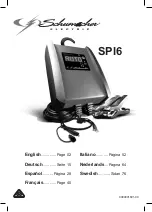
E-Series
8 of 20
User’s Manual
5.1 Off-Board Chargers
Off-board chargers are designed to be used in shelf or portable applications. They include rubber feet. If the
AC input plug is connected to AC power, a new charge cycle automatically starts when the DC output is
connected to a battery pack of the proper voltage. Disconnecting and reconnecting AC power while the DC
output remains connected to a battery pack WILL NOT automatically start a new charge cycle (unless a
storage mode condition has been met). Disconnecting the DC output from the battery pack IS REQUIRED
to automatically start a new charge cycle.
5.2 On-Board Chargers
On-board chargers are designed to be mounted on electric vehicles/equipment. They include steel feet with
a pattern that provides numerous mounting options (see Section 6.1). If the DC output is connected to a
battery pack of the proper voltage, a charge cycle automatically starts when the AC input plug is connected
to AC power (unless a safety period of time has not passed since the successful completion of the previous
charge cycle). Disconnecting the DC output from the battery pack is NOT REQUIRED to automatically start
a new charge cycle.
6. LOCATION AND INSTALLATION
WARNING: DO NOT INSTALL THE CHARGER ON OR NEAR FLAMMABLE MATERIALS. POSITION
THE CHARGER ON A FOUNDATION OF STONE, BRICK, CONCRETE OR GROUNDED METAL.
WARNING: CHARGERS CAN IGNITE FLAMMABLE MATERIALS AND VAPORS. DO NOT USE NEAR
FUELS, GRAIN DUST, SOLVENTS, THINNERS, OR OTHER FLAMMABLES.
The charger may have been attached to a plywood board in the factory to protect it during shipping. If so remove
the plywood shipping board before installation and operation of the charger.
Proper installation of the charger is important in order to achieve good performance and to prevent damage to the
charger and batteries. The charger should be located in a clean, cool, dry, and well ventilated area. To permit
free airflow for convection cooling, allow 2 inches (5.08 cm) minimum between the charger ventilation openings
and any walls or other objects. Do not obstruct the airflow space around and beneath the charger.
Do not allow
clothing, blankets, or other materials to cover the charger.
Install the charger in an area where the temperatures will remain within the range of -4 °F to 113 °F (-20 °C to 45
°C) and the relative humidity will remain below 95 percent (%). Exceeding these ranges will reduce the current
capacity and possibly the service life of the charger. If the charger will be operated outside of these ranges,
contact your dealer to verify if it will withstand these conditions and perform at the needed capacity.
Do not operate the charger with a damaged AC or DC cable or connector. Do not operate the charger if it has
received a sharp blow, was dropped, or was otherwise damaged in any manner. Contact your dealer.
WARNING: REPLACE WORN, DAMAGED, OR CUT ELECTRICAL CORDS AND PLUGS IMMEDIATELY.
WARNING: KEEP DRY; DO NOT EXPOSE TO RAIN OR SPRAY. FOR STORAGE, KEEP CHARGER IN A
BUILDING. NE PAS EXPOSER A LA PLUIE.
6.1 On-Board Mounting
On-board E-Series chargers are designed to be mounted on electric vehicles/equipment. They include steel
feet with a pattern that provides numerous mounting options. A dimensional drawing of the on-board
mounting pattern is provided in Figure 6.1-1.






































